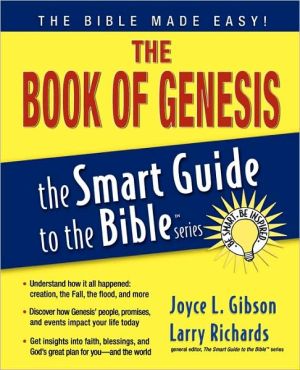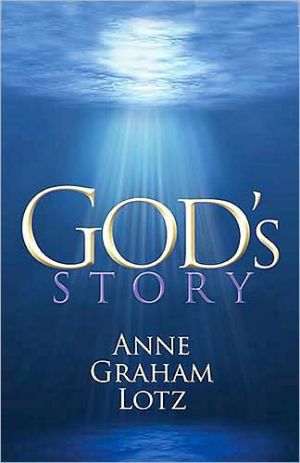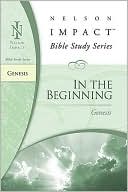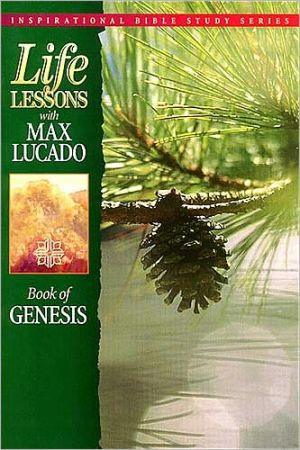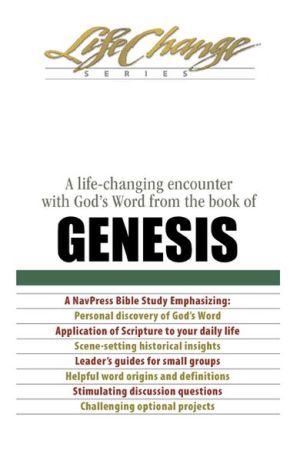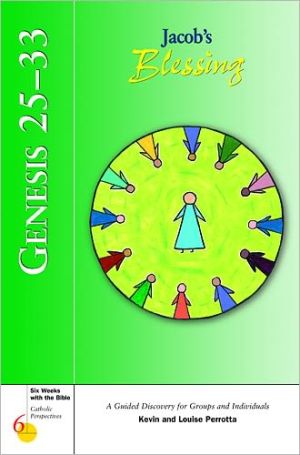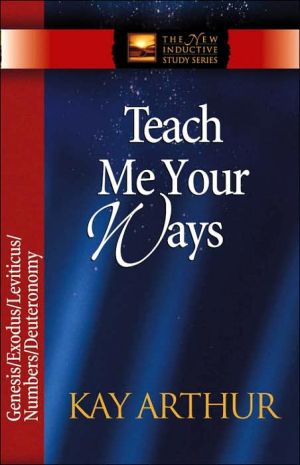Genesis 12-23
The story of Abraham is where the great drama of our own redemption begins. In Genesis 12–23: Abraham and Sarah's Journey, authors Kevin and Louise Perrotta recount the story in a way that helps us clearly see the story of Abraham and Sarah as our own story. This guide includes helpful historical and cultural notes about Abraham and Sarah.\ \ A Guided Discovery of the Bible The Bible invites us to explore God’s word and reflect on how we might respond to it. To do this, we need guidance and...
Search in google:
Created for both individual and group use, each six-week discovery guide focuses on a specific book of the Bible. Weekly sections feature key passages along with related questions that encourage adults to explore the Bible for themselves and learn how it applies to their daily lives. These guides are designed for busy adults who wish to deepen their relationship with God and strengthen their understanding of Scripture. This particular volume explores Genesis 12-23.
How to Use This Guide\ \ You might compare the Bible to a national park. The park is so large that you could spend months, even years, getting to know it. But a brief visit, if carefully planned, can be enjoyable and worthwhile. In a few hours you can drive through the park and pull over at a handful of sites. At each stop you can get out of the car, take a short trail through the woods, listen to the wind blowing through the trees, get a feel for the place.\ In this booklet we’ll drive through a small portion of the Bible, making half a dozen stops along the way. At those points we’ll proceed on foot, taking a leisurely walk through the selected passages. The readings have been chosen to take us to the heart of the Genesis accounts of Abraham and Sarah, the ancestors of Israel and the Church. After each discussion we’ll get back in the car and take the highway to the next stop.\ This guide provides everything you need to begin exploring Abraham and Sarah’s story in six discussions—or to do a six-part exploration on your own. The introduction on page 6 will prepare you to get the most out of your reading. The weekly sections feature key passages about Abraham and Sarah, with explanations that highlight what their lives mean for us today. Equally important, each section supplies questions that will launch you into fruitful discussion, helping you to both explore the passages for yourself and learn from one another. If you’re using the booklet by yourself, the questions will spur your personal reflection.\ Each discussion is meant to be a guided discovery.\ Guided. None of us is equipped to read the Bible without help. We read the Bible for ourselves but not by ourselves. Scripture was written to be understood and applied in the community of faith. So each week “A Guide to the Reading,” drawing on the work of both modern biblical scholars and Christian writers of the past, supplies background and explanations. The guide will help you grasp the message of the Genesis readings. Think of it as a friendly park ranger who points out noteworthy details and explains what you’re looking at so you can appreciate things for yourself.\ Discovery. The purpose is for you to interact with Genesis. “Questions for Careful Reading” is a tool to help you dig into the text and examine it carefully. “Questions for Application” will help you consider what these words mean for your life here and now. Each week concludes with an “Approach to Prayer” section that helps you respond to God’s word. Supplementary “Living Tradition” and “Saints in the Making” sections offer the thoughts and experiences of Christians past and present in order to show you what the Abraham and Sarah accounts have meant to others—so that you can consider what they might mean for you.\ How long are the discussion sessions? We’ve assumed you will have about an hour and a half when you get together. If you have less time, you’ll find that most of the elements can be shortened somewhat.\ Is homework necessary? You will get the most out of your discussions if you read the weekly material and prepare your answers to the questions in advance of each meeting. But if participants are not able to prepare, have someone read the “What’s Happened” and “Guide to the Reading” sections aloud at the points where they appear.\ What about leadership? If you happen to have a world-class biblical scholar in your group, by all means ask him or her to lead the discussions. But in the absence of any professional Scripture scholars, or even accomplished biblical amateurs, you can still have a first-class Bible discussion. Choose two or three people to be facilitators, and have everyone read “Suggestions for Bible Discussion Groups” (page 76) before beginning.\ Does everyone need a guide? a Bible? Everyone in the group will need their own copy of this booklet. It contains the sections of Genesis that are discussed, so a Bible is not absolutely necessary—but each participant will find it useful to have one. You should have at least one Bible on hand for your discussions. (See page 80 for recommendations.)\ How do we get started? Before you begin, take a look at the suggestions for Bible discussion groups (page 76) and individuals (page 79).\ Our Grandfather and Grandmother in Faith\ \ Let’s suppose we asked you to tell us about faith in God. How would you explain it? If this were a Web site, you could type in your response. Since booklets are not interactive (but see page 80), we’ll have to make a guess at your response. We bet that your answer includes a story about someone whose life demonstrates the impact of faith. The reason for our guess is that we cannot imagine answering the question ourselves without using such a story. Pointing to a person of deep faith is a concrete way of showing the difference that faith makes.\ The many people of faith whom we have met in the course of our lives have helped us form our mental pictures of faith. Over several decades we have watched them make decisions with the conviction that God was with them and was calling them to live a certain way. We would guess that you have arrived at your concept of faith by similar observations. Not only men and women we have known, but also some we have never met, have fleshed out our idea of faith in God. Surely all of us have heard or read about saints. In saints, faith stands out like muscles on a weight lifter.\ Most of us are not accustomed to calling the Old Testament patriarchs and matriarchs “saints.” But in fact, Catholic liturgical traditions of the East and West do honor them as saints—a tradition that goes back to New Testament times (see Hebrews 11). Whatever titles we give them, these men and women of the Old Testament continue to illustrate the life of faith for us. Two of the most notable Old Testament models of faith happen to be the first people whose life stories are recounted at length in the Bible—a married couple named Abraham and Sarah.\ Abraham and Sarah’s life together is a journey of faith. It begins at some hard-to-determine time in the thousand years before 1250 b.c. at Ur, one of the oldest cities in the world (today an archaeological site in southern Iraq). Abraham and Sarah, however, are not city folk. They are members of the tribes that live on the fringes of the city and the irrigated farmlands. Keepers of sheep, goats, and cattle, these people dwell in family groups, moving often in search of pasturage. Generally they follow an annual circuit from valley to hill country and back again. Since their flocks and herds and the donkeys they use for transport must drink frequently, these pastoralists never travel far into the desert but stay close to settled areas, where water is available and they can trade livestock for necessities. Theirs is a precarious existence, always shadowed by the possibility of drought or trouble from townspeople. If we were to picture one of these seminomadic groups, we might imagine a cluster of tents; a couple dozen people with dark eyes, dark hair, and weathered faces; and women adorned with gold and silver ornaments, against a background of sparse vegetation under a blazing sun.\ Abraham and Sarah belong to such a group, led by Abraham’s father, Terah. Breaking with the annual cycle of pasturing near Ur, Terah leads his band of relatives and slaves northwest along the Euphrates River on a journey of hundreds of miles to a town called Haran (in modern southeast Turkey). There the group settles, and there Abraham and Sarah grow old (Genesis 11:27–31).\ The pair grows old without having children. This would be a sorrow for any married couple; in Abraham and Sarah’s family-centered world, the lack of an heir is a disaster. Their lives seem to have reached a dead end. But in the plans of God, whose strength is made perfect in weakness, the elderly pair are only now ready for the great adventure that he has in mind for them.\ Abraham and Sarah belong to a culture in which people worship the moon god Sin and other such deities. Quite possibly Abraham and Sarah share in these practices. Yet one day, the God described in the earlier chapters of Genesis as the sole creator of the universe speaks to Abraham. God tells Abraham that he will make him “a great nation” (12:2—references in this booklet are to Genesis unless otherwise noted) and instructs him to set out for a land unspecified. In faith and obedience, evidenced by their unquestioning and uncomplaining response, the couple pulls up stakes and heads southwest. A few hundred goat-and-donkey miles down the road, God makes it clear that the land he means is Canaan (12:6–7)—present-day Israel and Palestinian territories. In fact, God now tells them that he is going to give this land to their offspring (12:7). But how can that happen, since the land is already populated and the couple has no children? This question dominates their lives for many years.\ Not wanting to spoil the pleasure of discovery for first-time readers, we will pass over the details that follow. We will say that there are both high points and low points in Abraham’s and Sarah’s responses to the situation. To be honest, they are not the most saintly of saints. The biblical authors and editors portray them as a couple with weaknesses and flaws as well as deep faith in God. The pair obeys God, but their obedience is marred by skepticism—and they are not always kind or fair to other people. Yet not only their positive responses to God but also their negative responses supply us with food for thought about what it means to live by faith.\ What kind of writings are the Abraham and Sarah narratives? This is a question of vital importance if we are to understand these stories and grasp their meaning for us. The way to begin to understand what kind of writings these stories are is to examine how they came into existence.\ Abraham and Sarah and their family probably did not read and write. They belonged to a culture of memory rather than of writing, of oral rather than of written communication. Their descendants would have passed on the stories about them by word of mouth. Over time, the couple became towering figures in their family’s and nation’s memory. The prophet Isaiah spoke of Abraham and Sarah as the “rock” from which Israel was hewn, the “quarry” from which Israel was dug (Isaiah 51:1–2). After being told and retold for generations, the accounts were written down, rewritten, and revised. Scholars disagree about who did the handing on, the writing down, and the editing. The whole process may have taken more than a thousand years.\ Stories of honored figures of the past that have been orally handed on for generations and then written down as expressions of national heritage—this description makes the Genesis accounts sound like an epic, such as the Anglo-Saxon Beowulf and the Greek Odyssey. Although these epic poems relate imaginative stories, they are set against a real historical background and feature central characters who were probably actual men and women. Somewhat similar are the Icelandic sagas, which tell legendary tales about heroic figures, such as the Vikings who discovered Canada. The accounts in such epics and sagas have been shaped to speak to later generations about themes of lasting importance: daring, endurance, faithfulness, suffering, the brevity of life.\ The Abraham and Sarah stories have a partial but instructive modern parallel. Author Alex Haley’s book and video series, Roots (1976), traces the African origins of his family, beginning with his great-great-great-great-grandfather, who came to Maryland as a slave in 1767. Haley spends more than half the book telling about this ancestor, Kunta Kinte—his youth in West Africa, his kidnapping, his transport on a slave ship, his attempts to escape, his forty years of slavery in Virginia. Then he tells about Kunta Kinte’s daughter, grandson, great-grandson, great-great-granddaughter, and great-great-great-granddaughter, who was Alex Haley’s mother. These are all real people. Haley built his book on a skeleton of facts that were handed on in an oral tradition in his family. He filled in the social and cultural background of rural Africa and the pre–Civil War South with historical research. Against this background, he used fictional techniques to compose what is, in part, a historical novel.\ There are vast differences between how Genesis and Roots were composed. But in both cases, stories about ancestors were handed on for generations by word of mouth and were eventually written down and reshaped in order to bring out a contemporary message.\ Equally important, both are family stories. Roots is essentially the story of a family that extends through time, embracing all seven generations from Kunta Kinte to Alex Haley. Haley regards all seven generations as “our family,” “us.” Kunta Kinte stands as the family’s representative: he gives the family its character. Succeeding generations understand who they are by remembering him. The family develops the custom of gathering together around each newborn infant and telling again the story of Kunta Kinte. Kunta Kinte’s story is the family story, the story that all the members identify with and share in. The members of this family are not isolated individuals. They are each a part of the family and play their parts in a larger, family story—a story of courage and loyalty through thick and thin, of endurance in the face of oppression and brutality.\ Roots gives us insight into what the patriarchal stories were for the Israelites. Like Alex Haley, the people who told the Genesis stories saw themselves as part of a family that extended over many generations—a family whose story was first lived out by their ancestors Abraham and Sarah.\ What was the larger family story that Israelite readers found in the accounts of Abraham and his family? The account begins with God calling Abraham to leave home and go to a land God will give him (12:1,7). This introduces the dominant, central theme of the accounts: God’s promise of the land.\ This theme was of tremendous importance to the Israelites, especially at the time when these stories were put in the form in which we find them in the Bible. In the view of many scholars, the patriarchal accounts were completed in the sixth century b.c. by Israelites living in Babylon, in exile from the land. These exiled Israelites treasured the story of God promising the land to Abraham because they were part of Abraham’s family, and thus the story of God’s promises to him was their story too. The story conveyed God’s promise of the land to them.\ Abraham was promised a land and descendants who would possess it. Yet for years he and Sarah lived as resident aliens in the land and had no children. Their life was a journey in faith and trust. Their Israelite descendants saw their own situation reflected in these stories. In exile, they too held on to prophetic promises from God that went unfulfilled from year to year. Like Abraham and Sarah, they too hoped against hope that God would accomplish what seemed humanly impossible and reestablish them in the land. God’s gift of a son to aged Abraham and Sarah stood as a sign that he would also fulfill his promise of restoration to the exiles.\ If the Abraham and Sarah stories were like Roots for the ancient Israelites, the great question for Christian readers is how can their stories be like Roots for us? How can this be our family story? The answer lies in the fact that by becoming followers of Abraham and Sarah’s descendant, Jesus, we have joined their family. Through Jesus, we can regard Abraham and Sarah as our ancestors. The Catholic Catechism calls Abraham “the father of all believers” (Catechism of the Catholic Church, section 1080).\ Since we are part of the family, the family story becomes our story. But just as we have joined this family through Jesus, we understand it in light of Jesus. The story of Abraham and Sarah centers on God’s promise of the land. What is this Promised Land in the light of Christ? Jesus declared that he fulfilled all the promises that God had made to Israel. But he fulfilled them in an unexpected manner. He came to gather God’s people not into the land of Israel but rather into the community of his followers. He came to establish not a kingdom in an earthly land but rather a kingdom over evil and death, an eternal kingdom entered through resurrection. The land that Jesus promises us is the kingdom of God: heaven, the new Jerusalem. The Catechism says that “the gift of the land promised to Abraham’s descendants” is “an image of eternal life” (section 1222).\ Thus we read the stories of Abraham and Sarah being called to go out in faith toward a land that God would give them as a metaphor for the life of Jesus’ followers, who are called to follow him into the kingdom of God. This is exactly how the writers of the New Testament thought about Abraham. The author of Hebrews wrote: “By faith Abraham obeyed when he was called to set out for a place that he was to receive as an inheritance; and he set out, not knowing where he was going. By faith he stayed for a time in the land he had been promised, as in a foreign land. . . . For he looked forward to the city that has foundations, whose architect and builder is God” (Hebrews 11:8–10). The writer sees Abraham as a model for us in our longing for the true land of promise—the eternal city with God. Abraham is an example of one who does not turn back from the call to discipleship but presses on, desiring “a better country . . . a heavenly one” (Hebrews 11:16).\ As Christians, we experience times when God seems to have forgotten about us, when his promises of life and peace seem to go unfulfilled, when we see little evidence of his kingdom amid much injustice and suffering. We go through dark nights, when we find little external support for our faith and we have to simply trust God. In all of this, Abraham and Sarah are our models. “By faith he received power of procreation, even though he was too old—and Sarah herself was barren—because he considered him faithful who had promised. Therefore from one person, and this one as good as dead, descendants were born, ‘as many as the stars of heaven’” (Hebrews 11:11–12).\ On our way to the land promised to us, we face dangers, we make mistakes, we fight with one another, we even betray one another. God tests our faith in him and our love for one another. We experience God’s faithfulness. We can see all of this in the lives of Abraham and Sarah, our grandfather and grandmother in faith. We can read their story as our story.\ Let’s return to the historical question. Do these accounts of Abraham and Sarah convey real history? Did the events in Genesis 12 to 50 actually happen? Scholarly opinion is divided.\ Some experts think that the Abraham and Sarah accounts in Genesis contain a great deal of historically authentic material. They point to the fact that the accounts reflect customs that we know were practiced in the ancient Near East in earlier times, before the period of Israel. For example, archaeologists have found material that substantiates the approach to inheritance that Abraham refers to in 15:2, and they have found laws regulating the stratagem for gaining offspring that Sarah employs in 16:2. But these historical parallels come from different places and historical periods, which suggests that the accounts originated or were reshaped in a succession of historical settings.\ Other scholars think that the narratives were composed without much basis in fact. This is hard to disprove, since no corroborating records of Abraham and Sarah exist. Yet there is good reason to think that real people and events lie behind the stories in Genesis 12 to 50. Abraham, for example, engages in religious practices that were at variance with the later law of Moses (compare Genesis 21:33 with Deuteronomy 16:21). If the Israelites had set out to simply make up stories about their ancestors, it is unlikely that they would have made up stories that showed their ancestors practicing a different kind of religion from their own.\ Regarding the historical nature of these accounts, a middle position may be the soundest. It is possible that there was an Abraham and a Sarah, and it is possible that they were guided by God as they traveled from the east to present-day Israel and Palestinian territories, and God did make a covenant with them, give them promises, and bless them. Yet over many centuries of being passed on orally, the stories underwent major changes. The narratives are not history in our modern sense.\ This does not diminish their value or impugn their character as the word of God. Some may think that in order to maintain that these accounts are the word of God, it is necessary to accept them as historical in the modern sense. But historical writing is not the only kind of writing through which God may reveal himself. God can inspire many forms of writing. He may—and in the Bible, he does—speak through poems and prayers, short stories and letters, visions and oracles, folk sayings, essays, and sagas. Truth comes in various forms. In the Abraham and Sarah narratives, what counts is that God guided the tellers, writers, and editors so that the outcome would convey the meanings he wished to convey.\ Final notes before beginning. We have been referring to “Abraham” and “Sarah.” However, when the couple first appear, they bear the names “Abram” and “Sarai.” Essentially there is no difference in meaning between the earlier and later forms of their names, although their renaming by God is a significant point in the story. We will use the earlier forms in the sections of this booklet that deal with the Genesis accounts prior to their renaming.\ Editor’s note: Kevin and Louise worked together on this booklet. Louise wrote the guides to the reading for Weeks 1, 2, and 3 and the view of Sarah on page 74, and Kevin was the main author of the guides for Weeks 4, 5, and 6.\ Week 1\ Leaving Home\ \ Questions to Begin\ 15 minutes Use a question or two to get warmed up for the reading.\ \ 1 Describe your most unexpected trip.\ 2 What are your feelings about travel?\ ? I’m ready to pack at a moment’s notice.\ ? I get restless if I don’t hit the road every so often.\ ? It depends. (What does it depend on for you?)\ ? I love it, so long as I can stay in five-star hotels.\ ? If I never have to go more than a hundred miles from home, I’m happy.\ \ Opening the Bible\ 5 minutes Read the passage aloud. Let individuals take turns reading paragraphs.\ \ The Reading: Genesis 11:26–13:2\ God Says Go\ 11:26 When Terah had lived seventy years, he became the father of Abram, Nahor, and Haran.\ 27 Now these are the descendants of Terah. Terah was the father of Abram, Nahor, and Haran; and Haran was the father of Lot. 28 Haran died before his father Terah in the land of his birth, in Ur of the Chaldeans. 29 Abram and Nahor took wives; the name of Abram’s wife was Sarai, and the name of Nahor’s wife was Milcah. She was the daughter of Haran the father of Milcah and Iscah. 30 Now Sarai was barren; she had no child.\ 31 Terah took his son Abram and his grandson Lot son of Haran, and his daughter-in-law Sarai, his son Abram’s wife, and they went out together from Ur of the Chaldeans to go into the land of Canaan; but when they came to Haran, they settled there. 32 The days of Terah were two hundred five years; and Terah died in Haran.\ 12:1 Now the Lord said to Abram, “Go from your country and your kindred and your father’s house to the land that I will show you. 2 I will make of you a great nation, and I will bless you, and make your name great, so that you will be a blessing. 3 I will bless those who bless you, and the one who curses you I will curse; and in you all the families of the earth shall be blessed.”\ 4 So Abram went, as the Lord had told him; and Lot went with him. Abram was seventy-five years old when he departed from Haran. 5 Abram took his wife Sarai and his brother’s son Lot, and all the possessions that they had gathered, and the persons whom they had acquired in Haran; and they set forth to go to the land of Canaan. When they had come to the land of Canaan, 6 Abram passed through the land to the place at Shechem, to the oak of Moreh. At that time the Canaanites were in the land. 7 Then the Lord appeared to Abram, and said, “To your offspring I will give this land.” So he built there an altar to the Lord, who had appeared to him. 8 From there he moved on to the hill country on the east of Bethel, and pitched his tent, with Bethel on the west and Ai on the east; and there he built an altar to the Lord and invoked the name of the Lord. 9 And Abram journeyed on by stages toward the Negeb.\ An Unheroic Husband\ 10 Now there was a famine in the land. So Abram went down to Egypt to reside there as an alien, for the famine was severe in the land. 11 When he was about to enter Egypt, he said to his wife Sarai, “I know well that you are a woman beautiful in appearance; 12 and when the Egyptians see you, they will say, ‘This is his wife’; then they will kill me, but they will let you live. 13 Say you are my sister, so that it may go well with me because of you, and that my life may be spared on your account.” 14 When Abram entered Egypt the Egyptians saw that the woman was very beautiful. 15 When the officials of Pharaoh saw her, they praised her to Pharaoh. And the woman was taken into Pharaoh’s house. 16 And for her sake he dealt well with Abram; and he had sheep, oxen, male donkeys, male and female slaves, female donkeys, and camels.\ 17 But the Lord afflicted Pharaoh and his house with great plagues because of Sarai, Abram’s wife. 18 So Pharaoh called Abram, and said, “What is this you have done to me? Why did you not tell me that she was your wife? 19 Why did you say, ‘She is my sister,’ so that I took her for my wife? Now then, here is your wife, take her, and be gone.” 20 And Pharaoh gave his men orders concerning him; and they set him on the way, with his wife and all that he had.\ 13:1 So Abram went up from Egypt, he and his wife, and all that he had, and Lot with him, into the Negeb.\ 2 Now Abram was very rich in livestock, in silver, and in gold.\ \ Questions for Careful Reading\ 10 minutes Choose questions according to your interest and time.\ \ 1 How old was Terah when Abram left him (see 11:26; 12:4)? How much of Terah’s later life did Abram miss by leaving Haran (see 11:32)?\ 2 What is the attitude toward slavery in this account? Cite specific statements.\ 3 Using maps in your Bible or a Bible atlas, locate Ur, Haran, Shechem (pronounced Shékem), Bethel, and the Negeb (pronounced Négev) desert (11:31; 12:6, 8, 9). Roughly how far was it from Ur to Haran? from Haran to Shechem?\ 4 What impression of God do you get from reading the promise of 12:7 against the background statements regarding Sarai and the land (11:30; 12:6)? What impression of Abram do you get from reading 12:11–13 against the background of 12:2–3?\ 5 In light of the outcome of the situation in Egypt, did Abram misjudge the Egyptians?\ \ A Guide to the Reading\ If participants have not read this section already, read it aloud. Otherwise go on to “Questions for Application.”\ \ With a sudden, dramatic command to an unknown named Abram, the creator breaks his ten-generation silence toward the human race. “Go,” says the voice that has been unheard by any man or woman since Noah (Genesis 9:8–17). Abram and his wife, Sarai, are in their golden years, but his immediate acceptance of the journey marks the beginning of a new life for the couple and a fresh start for all the peoples of the earth.\ Up till now, the only drama in Abram’s life seems to have been of the ordinary domestic sort. His family history hints at a struggle to continue the family line. Abram is one of three sons born to Terah, who began fathering them at seventy—twice the age of his forebears (11:12–24, 26). One son, Haran, has already died (11:28), leaving a boy, Lot, and two girls. Abram and his brother Nahor are married but childless; a significant aside to the family history makes a point of stressing that Sarai is “barren” (11:30). In a society without Medicare or Social Security, this scarcity of heirs and caregivers must be a serious concern.\ Cutting straight through to this deep anxiety, God astounds Abram with promises that strain credulity. Never mind that Abram is in his seventies and Sarai is in her sixties and they have never been able to conceive: Abram will father not just an heir but “a great nation” (12:2). He will exchange the social stigma of childlessness for such God-given prestige and prosperity that his name will become a byword for blessing (12:2). “May God make me as blessed as Abram,” people will say, just as today’s would-be millionaires might voice the hope of becoming “as rich as Bill Gates.” In some mysterious way, Abram will even become a channel of blessing for “all the families of the earth” (12:3)—for us!\ Notice that the promise includes a guarantee of divine protection. If Abram accepts his call, God will stand by him, blessing anyone who takes his side and opposing anyone who doesn’t (12:3). What better travel insurance could be imagined for a journey into unknown and potentially hostile territory?\ Not that the choice Abram faces is an easy one. Following this God and receiving these promises require a radical break with the past. The cost of discipleship is spelled out in three specific relinquishments (12:1): Abram must leave “country,” “kindred” (extended family), and “father’s house” (more immediate family). Even for a seminomad, this demand for total separation is enormous. Scripture leaves us to imagine the departing couple’s inner struggle and stresses the outcome: “Abram went” (12:4).\ Do Abram and Sarai and their traveling party have a sense of déjà vu as they set out? They had been Canaan-bound once before, when Terah led them out of Ur. Now, with God’s command picking up where Terah’s personal agenda left off, the original relocation plan is realized (compare 11:31 and 12:5).\ Abram and Sarai journey south through Canaan’s central hill country. At Shechem, a local Canaanite shrine, God appears and expands on his earlier promise: “To your offspring I will give this land,” he tells Abram (12:7). “Yeah, right,” we might well imagine Abram responding. “Tell that to these Canaanites!” (see 12:6). Instead, Abram builds an altar, an expression of his faith in God’s word. As they move through the Promised Land, Abram will repeat this action, acknowledging God and symbolically setting down roots by building altars at Canaanite shrines (12:7, 8; 13:18).\ This shining portrayal of a man of perfect faith and unwavering obedience is clouded by Abram’s first recorded words. Driven into Egypt by famine, where his immigrant status and Sarai’s apparently ageless good looks make him especially vulnerable, Abram forgets God’s promise of protection and proposes a plan to save his skin (12:11–13). Sarai indicates assent by her silence, but Abram’s willingness to jeopardize her honor may leave us protesting. Perhaps he hopes to fend off Sarai’s prospective suitors by putting them off indefinitely—not a workable plan when, unexpectedly, the suitor is Pharaoh.\ All ends well, but only because God demonstrates his protective power. Pharaoh is warned off, Sarai’s honor is preserved (a parallel story in chapter 20 makes this clear), and Abram is left squirming in embarrassed silence before the Egyptian’s reproach (12:18–19). It will be some time before this weak but chosen instrument can trust God completely enough to become a blessing to “all the families of the earth” (12:3).\ Questions for Application\ 40 minutes Choose questions according to your interest and time.\ \ 1 Terah intended to lead his family from Ur to Canaan (11:31), apparently without having received any special guidance from God. Yet this placed his son Abram closer to God’s long-range goal for him (12:1, 6–7). When have decisions by your family, made for ordinary reasons, later seemed to have advanced God’s plans for certain members of the family?\ 2 When have you had to part from your family? What was the hardest aspect of the separation? How did God use the separation for good?\ 3 In response to God’s promise, Abram and Sarai left Haran and set out on their life journey. In what way is every Christian’s life a response to a promise from God? The letter to the Hebrews develops this theme; see 10:35–36; 11:8–16. How does your life bear the character of a trusting response to God’s promises? How should it?\ \ 4 What do you think of Abram’s strategem in 12:11–13?\ 5 Pharaoh reproaches Abram for having a low opinion of his integrity (12:18–19). When have you mistakenly assumed that someone would act badly? What did you learn from your experience?\ 6 In what areas of life do you feel too old to make a new start? Where might God be inviting you to overcome this feeling?\ \ The benefit of Bible study is . . . in obeying the voice of the Lord—receiving what he says and putting it into practice. Application doesn’t happen by osmosis or by chance; application is by intent.\ The Navigator Bible Studies Handbook\ Approach to Prayer\ 15 minutes Use this approach—or create your own!\ \ ♦ Pray together this prayer and an Our Father.\ O God of Abram and Sarai, you make seemingly impossible promises. You call people who seem ill equipped to respond to you. In the resurrection of your Son you promise us eternal life. In the gift of your Spirit you give us the power to love. Help us to trust in your promise and to cooperate with your Spirit.\ A Living Tradition This Really Is Marriage?\ This section is a supplement for individual reading.\ \ Abram’s request that Sarai pretend they are not married (Genesis 12:11–13) is quite a shocker. It has evoked many different interpretations, which are as interesting for what they suggest about the interpreters as for the light they shed on Genesis.\ St. John Chrysostom, a prominent fourth-century bishop, offered a provocative interpretation. John found Sarai’s willingness to cooperate with Abram’s plan understandable under the circumstances. Abram’s “pitiful appeal” to Sarai touched her heart, John said, and persuaded her to go along with his strategem. John found something to admire here. “This really is marriage!” he remarked. “For two people to adapt themselves not only to relaxations but to dangers is a sign of genuine love, a mark of true friendship. Do you see the bond of love between husband and wife? Do you see what sort of thing he was confident to ask of her, what sort of recommendation she was willing to receive? Let husbands and wives listen and copy the harmony of this pair, their bond of love, the intensity of their loyalty.” The modern reader will probably find this a bit much! It is one thing to understand the way flawed human beings act under great pressure. It is quite another to commend their willingness to commit adultery as an example of marital loyalty.\ At the same time, John did not exonerate Abram. “While most husbands find nothing more offensive than the mere suspicion that their wife has committed adultery . . . Abram earnestly did everything so that the adultery should actually occur!” Yet, John pointed out, Abram acted in order to escape death, and his fear of dying was understandable. Christ had not yet come to release men and women from death’s tyranny.\ So we see John wrestling with this difficult passage. If we are not persuaded by his interpretation, perhaps we may nevertheless admire his sympathetic view of human weakness and his sensitivity to the difficult choices that hungry people sometimes face. We may also welcome his ideal of marriage, even if we do not think that Abram and Sarai have attained it. Personally, I admire John’s ability to appreciate good qualities in people even when they are doing something wrong. What do you think?
How to Use This Guide4Our Grandfather and Grandmother in Faith6Week 1Leaving Home - Genesis 11:26-13:214Week 2Family Dissension - Genesis 15:1-11, 17-18; 16:1-1624Week 3You Make Me Laugh - Genesis 17:1-10, 15-23; 18:1-1534Week 4Fulfillment and Loss - Genesis 21:1-2144Week 5The Supreme Test - Genesis 22:1-1954Week 6A Resting Place in the Land - Genesis 23:1-2064More Than Just a Pretty Face74Suggestions for Bible Discussion Groups76Suggestions for Individuals79Resources80

